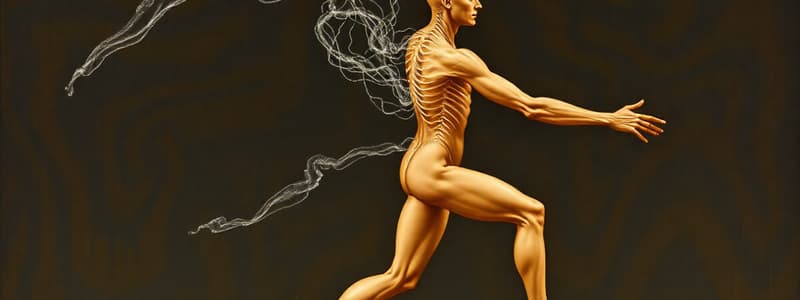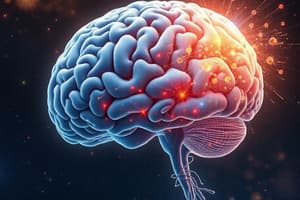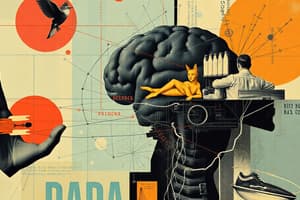Podcast
Questions and Answers
Which statement accurately describes the role of the neocortex in motor control?
Which statement accurately describes the role of the neocortex in motor control?
- It directly activates muscles for movement execution.
- It relays all sensory information to other brain regions.
- It primarily processes visual information, such as color and depth perception, essential for guiding movements.
- It serves as the 'controller of the controllers', coordinating higher-level motor functions through its four lobes. (correct)
Damage to the vestibulocerebellum would most likely result in which of the following deficits?
Damage to the vestibulocerebellum would most likely result in which of the following deficits?
- Problems with balance and error correction. (correct)
- Impaired visual and auditory processing.
- Inability to plan and initiate movements.
- Difficulty with coordinated trunk movements.
How does sensory information contribute to movement preparation?
How does sensory information contribute to movement preparation?
- It primarily affects long-term motor skill development, not immediate movement preparation.
- It provides stimuli and information necessary for planning and executing motor actions. (correct)
- It bypasses the brain and directly stimulates muscle contractions.
- It directly activates the cerebellum for immediate motor responses.
What is the role of the spinocerebellum in motor control?
What is the role of the spinocerebellum in motor control?
Which of the following describes the interaction of the neocerebellum in motor control?
Which of the following describes the interaction of the neocerebellum in motor control?
A quarterback, when evaluating the field, is utilizing what type of attentional style?
A quarterback, when evaluating the field, is utilizing what type of attentional style?
Which of the following best describes the relationship between arousal and anxiety?
Which of the following best describes the relationship between arousal and anxiety?
According to the inverted-U hypothesis, what happens to performance as arousal levels increase beyond an individual's optimal level?
According to the inverted-U hypothesis, what happens to performance as arousal levels increase beyond an individual's optimal level?
A gymnast uses which sensory input to maintain balance on the beam?
A gymnast uses which sensory input to maintain balance on the beam?
Which scenario exemplifies state anxiety rather than trait anxiety?
Which scenario exemplifies state anxiety rather than trait anxiety?
Before executing a free throw, a basketball player focuses solely on the rim. This attentional style is best described as:
Before executing a free throw, a basketball player focuses solely on the rim. This attentional style is best described as:
Which of the following sensory receptors provides information about muscle tension?
Which of the following sensory receptors provides information about muscle tension?
What is the approximate duration of sensory memory?
What is the approximate duration of sensory memory?
Which factor primarily accounts for the increased reaction time as the number of stimulus-response alternatives increases, as described by Hick's Law?
Which factor primarily accounts for the increased reaction time as the number of stimulus-response alternatives increases, as described by Hick's Law?
In the psychological refractory period (PRP), why does the reaction time to the second stimulus increase when two stimuli are presented in quick succession?
In the psychological refractory period (PRP), why does the reaction time to the second stimulus increase when two stimuli are presented in quick succession?
During a sporting event, a quarterback fakes a handoff before passing the ball. This action is intended to exploit which aspect of an opponent's information processing?
During a sporting event, a quarterback fakes a handoff before passing the ball. This action is intended to exploit which aspect of an opponent's information processing?
Which of the following scenarios best illustrates the concept of 'event anticipation' in the context of reaction time?
Which of the following scenarios best illustrates the concept of 'event anticipation' in the context of reaction time?
According to single-channel filter theories of attention, what happens when two tasks requiring attention are presented simultaneously?
According to single-channel filter theories of attention, what happens when two tasks requiring attention are presented simultaneously?
According to multiple-resource theories of attention, why might it be easier to perform two tasks simultaneously?
According to multiple-resource theories of attention, why might it be easier to perform two tasks simultaneously?
In the context of attention, what does 'selectivity' refer to?
In the context of attention, what does 'selectivity' refer to?
How does automaticity of a skill relate to attentional capacity?
How does automaticity of a skill relate to attentional capacity?
Flashcards
Central Nervous System (CNS)
Central Nervous System (CNS)
The central command center of the body, consisting of the brain and spinal cord; integrates sensory information and sends out motor messages.
Neocortex
Neocortex
The 'new outer shell' of the brain, responsible for controlling other brain areas and divided into four lobes.
Frontal Lobe
Frontal Lobe
Lobe responsible for motor functions, planning, and coordination.
Parietal Lobe
Parietal Lobe
Signup and view all the flashcards
Cerebellum
Cerebellum
Signup and view all the flashcards
Reaction Time (RT)
Reaction Time (RT)
Signup and view all the flashcards
Movement Time
Movement Time
Signup and view all the flashcards
Response Time
Response Time
Signup and view all the flashcards
Simple Reaction Time
Simple Reaction Time
Signup and view all the flashcards
Choice Reaction Time
Choice Reaction Time
Signup and view all the flashcards
Hick's Law
Hick's Law
Signup and view all the flashcards
Psychological Refractory Period (PRP)
Psychological Refractory Period (PRP)
Signup and view all the flashcards
Attentional Capacity
Attentional Capacity
Signup and view all the flashcards
Focus of Attention: Direction
Focus of Attention: Direction
Signup and view all the flashcards
Focus of Attention: Width
Focus of Attention: Width
Signup and view all the flashcards
Arousal
Arousal
Signup and view all the flashcards
Anxiety
Anxiety
Signup and view all the flashcards
State Anxiety
State Anxiety
Signup and view all the flashcards
Trait Anxiety
Trait Anxiety
Signup and view all the flashcards
Inverted-U Hypothesis
Inverted-U Hypothesis
Signup and view all the flashcards
Exteroception
Exteroception
Signup and view all the flashcards
Study Notes
- Understanding Movement Control involves looking at factors associated with movement preparation
- Identify attention theories, and understand how arousal levels affect performance
- Understand sensory contributions to movement and balance
- Differentiate between short-term, long-term, and working memory
Motor Control and the CNS
- The CNS (brain and spinal column) is the command center, integrating incoming sensory information, processing, and outgoing messages
- The brain weighs 3 lbs. & consists of 100 billion cells and Quadrillion synapses
- Einstein's brain was smaller than average and consumes 20-25% of our energy expenditure
- Adult brains can grow new neurons
Brain
- The Neocortex (Neo = “new”, Cortex = “outer shell") is the controller of the controllers and has 4 lobes: Frontal, Parietal, Temporal, and Occipital
- The Frontal lobe has several divisions that perform different motor functions like activating muscles, planning, and coordination
- The Parietal lobe receives sensory information from the skin and tongue and processes sensory information from eyes and ears
- The Occipital lobe processes information from retinas, color, depth perception, and motion
- The Temporal lobe combines visual and auditory information
- The Thalamus (command center) located below the cortex relays all sensory information
Cerebellum
- The Cerebellum ("little brain") is an important facet of motor activity
- The cerebellum enables higher-level motor coordination and allows learning via practice
- The areas of the cerebellum includes:
- Vestibulocerebellum which is responsible for error correction, balance involving vestibular and visual feedback
- Spinocerebellum which supports locomotion and coordinated trunk activity
- Neocerebellum which interacts with the prefrontal area and cortical areas
Movement Preparation
- Considers sensory information by providing stimuli and information to prepare
- Reaction time, attention and arousal are also considerations
Speed
- Reaction time (RT) measures the time between stimulus presentation and motor response initiation and indicates the speed of decision-making
- Movement time measures time from movement initiation to completion
- Response time encompasses Reaction time + Movement time
Stimulus-Response Alternatives
- Simple reaction time involves one decision, like at a stop sign
- Choice reaction time involves multiple decisions, like at a traffic light (Yellow, Red, Green, Green arrow, flashing yellow arrow)
- Hick's law (Hick-Hyman Law) states the more decisions one must make, the slower the decision time
Psychological Refractory Period (PRP)
- Reaction time is delayed when two stimuli requiring different responses are quickly presented consecutively
- The response to the first stimulus delays the ability to process a response to the second stimulus
Ruler Test
- Involves the use of one ruler for simple reaction time and two rulers for choice reaction time
- Simple reaction time involves temporal anticipation
- Choice reaction time involves temporal and event anticipation
Attention Concepts
- Capacity indicates attentional capacity is not limitless
- Selectivity states that attention is selected either intentionally or incidentally
- Focus indicates attention can be wide or narrow and internal or external
Theories of Attentional Capacity
- Single-channel filter theories states tasks are accomplished serially and the system can only process one task at a time
- Multiple-resource theories notes several attention mechanisms, each with limited capacity
- Tasks requiring a common mechanism will be difficult to perform simultaneously
Attentional Capacity
- Attentional capacity is critical for understanding automaticity of performance
- As skills become automatized, one can attend to other environmental aspects
Focus of Attention
- Direction indicates the focus location can be internal, within the individual, or external, in the environment
- Width indicates the amount of information attended to by the individual such as narrow when attending to one or two cues, or broad when attending to the entire visual field
Attentional Styles
- There are four attentional styles: internal broad, internal narrow, external broad, and external narrow
Arousal vs. Anxiety
- Arousal encompasses a general physiological and psychological activation, varying on a continuum from deep sleep to intense excitement
- Anxiety is a negative emotional state with feelings of nervousness, worry, and apprehension, usually associated with activation/arousal of the body to too high a level
Anxiety
- State anxiety indicates the anxiety level at a single point in time within a specific event or context and is relatively common
- Trait anxiety indicates a predisposition for anxiety in threatening situations and the general level of anxiety in someone's personality
- A calm individual may have increased anxiety in certain circumstances
Inverted-U Hypothesis
- Performance increases with arousal up to a point, then drops off once arousal surpasses the optimal level
- Too little arousal causes underperformance
Sensory Contributions
- Exteroception provides information about the external factors such as vision and audition
- Proprioception provides information about the state of the body, including the sense of movement and the relationship of body parts
- Vestibular apparatus, Joint receptors, Cutaneous receptors, Muscle spindles and Golgi tendon organs
Memory
- Memory encompasses the ability to recall things and learn from experience
- Sensory memory: Under 4 seconds; Includes iconic(vision), echoic(hearing), haptic(touch)
- Short-term memory: Stores information for only 20-30 seconds unless rehearsed
- Working memory: Temporarily stores recently presented material and retrieves long-term information for problem-solving, decision-making, and movement production
- Long-term memory: Involves semantic, procedural, and episodic memories and is relatively permanent
Studying That Suits You
Use AI to generate personalized quizzes and flashcards to suit your learning preferences.




